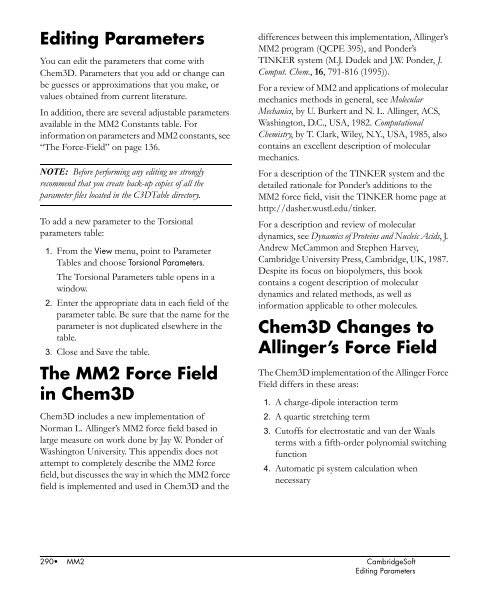Chem3D Users Manual - CambridgeSoft
Chem3D Users Manual - CambridgeSoft
Chem3D Users Manual - CambridgeSoft
Create successful ePaper yourself
Turn your PDF publications into a flip-book with our unique Google optimized e-Paper software.
Administrator<br />
Editing Parameters<br />
You can edit the parameters that come with<br />
<strong>Chem3D</strong>. Parameters that you add or change can<br />
be guesses or approximations that you make, or<br />
values obtained from current literature.<br />
In addition, there are several adjustable parameters<br />
available in the MM2 Constants table. For<br />
information on parameters and MM2 constants, see<br />
“The Force-Field” on page 136.<br />
NOTE: Before performing any editing we strongly<br />
recommend that you create back-up copies of all the<br />
parameter files located in the C3DTable directory.<br />
To add a new parameter to the Torsional<br />
parameters table:<br />
1. From the View menu, point to Parameter<br />
Tables and choose Torsional Parameters.<br />
The Torsional Parameters table opens in a<br />
window.<br />
2. Enter the appropriate data in each field of the<br />
parameter table. Be sure that the name for the<br />
parameter is not duplicated elsewhere in the<br />
table.<br />
3. Close and Save the table.<br />
The MM2 Force Field<br />
in <strong>Chem3D</strong><br />
<strong>Chem3D</strong> includes a new implementation of<br />
Norman L. Allinger’s MM2 force field based in<br />
large measure on work done by Jay W. Ponder of<br />
Washington University. This appendix does not<br />
attempt to completely describe the MM2 force<br />
field, but discusses the way in which the MM2 force<br />
field is implemented and used in <strong>Chem3D</strong> and the<br />
differences between this implementation, Allinger’s<br />
MM2 program (QCPE 395), and Ponder’s<br />
TINKER system (M.J. Dudek and J.W. Ponder, J.<br />
Comput. Chem., 16, 791-816 (1995)).<br />
For a review of MM2 and applications of molecular<br />
mechanics methods in general, see Molecular<br />
Mechanics, by U. Burkert and N. L. Allinger, ACS,<br />
Washington, D.C., USA, 1982. Computational<br />
Chemistry, by T. Clark, Wiley, N.Y., USA, 1985, also<br />
contains an excellent description of molecular<br />
mechanics.<br />
For a description of the TINKER system and the<br />
detailed rationale for Ponder’s additions to the<br />
MM2 force field, visit the TINKER home page at<br />
http://dasher.wustl.edu/tinker.<br />
For a description and review of molecular<br />
dynamics, see Dynamics of Proteins and Nucleic Acids, J.<br />
Andrew McCammon and Stephen Harvey,<br />
Cambridge University Press, Cambridge, UK, 1987.<br />
Despite its focus on biopolymers, this book<br />
contains a cogent description of molecular<br />
dynamics and related methods, as well as<br />
information applicable to other molecules.<br />
<strong>Chem3D</strong> Changes to<br />
Allinger’s Force Field<br />
The <strong>Chem3D</strong> implementation of the Allinger Force<br />
Field differs in these areas:<br />
1. A charge-dipole interaction term<br />
2. A quartic stretching term<br />
3. Cutoffs for electrostatic and van der Waals<br />
terms with a fifth-order polynomial switching<br />
function<br />
4. Automatic pi system calculation when<br />
necessary<br />
290• MM2 <strong>CambridgeSoft</strong><br />
Editing Parameters











